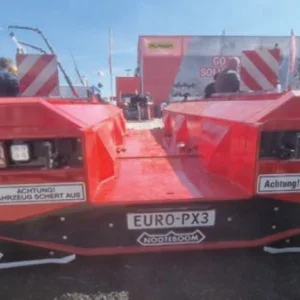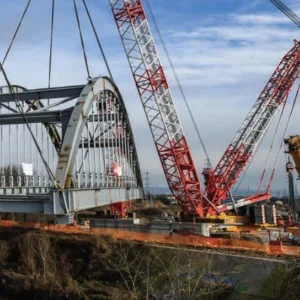When a floating crane makes a lift, it needs to drop anchor to keep it stable. In very deep water this is not possible. The answer then is dynamic positioning (DP) technology. However, while the weight of a very large load is being transferred from the crane to the load’s resting point, DP systems do not always work properly. Heerema Marine Contractors (HMC) now has software to solve this problem.
HMC operates three semi-submersible crane vessels, Balder, Hermod and Thialf, each of which is equipped with two large slewing cranes. They provide heavy lift installation and construction services to the offshore oil and gas industry worldwide. The smallest of the three, the 48,511 gross registered tonnes (GRT) Balder, can lift 6,300t using both of its cranes. The Thialf can lift a maximum of 14,200t.
Conventionally, a crane vessel is maintained in position and heading during lifts by anchors and anchor lines. By controlling the heading and position of the crane vessel it is possible to perform construction and installation activities.
The offshore industry is concentrating its investments in fewer but larger, more complex infrastructures in increasingly deeper waters. One of the main heavy lift applications of these large cranes is installing ‘topsides’ – upper structures of offshore platforms either onto a fixed steel or concrete platform mounted on the seabed, or onto a floating structure such as a tension leg platform (TLP) or moored, ballasted floating offshore installations (SPAR). The size and mass of the bodies involved are enormous and cause significant interaction effects. When installing topsides, single crane heavy lifts are typically 2,000t to 4,000t and tandem lifts are typically in the range of 4,000t to 12,000t.
When traditional anchoring is not possible, a dynamic positioning (DP) system makes it possible to maintain the vessel’s position and heading without any physical connection to the seabed. Thialf and Balder are both equipped with a DP system.
A DP system consists of three parts: sensors, a computer system and thrusters to make adjustments. Sensors, including satellite global positioning systems (GPS), record the position of the vessel. In response, computer systems activate thruster units to counteract wind, wave and current forces and to maintain the vessel’s position and heading.
Safety is the key issue of heavy lift operations. Such operations require the involvement of a lot of people and a major incident could endanger lives. The structures involved are so expensive that any loss or damage is a disaster for all involved. The design and operation of DP-systems specifically for critical DP-operations have been matured to reliable and safe standards. Hardware redundancy is required to ensure that single case failures do not affect the position-keeping capability of the DP-system.
Generally, DP control systems are designed and subsequently tuned for free-floating vessels. The performance of the DP system on free-floating vessels is good. The position accuracy (footprint) is generally within 1.0m2, which is extremely good when considering the dimensions of the crane vessels. The Hermod, for example, is about 13,000m2.
Topsides set-down
The installation of a topsides onto an offshore installation involves typically the following stages:
– the crane vessel is located at stand-off position and the topsides arrives in the field on a cargo barge
– slings are attached and the topsides is lifted off the cargo barge
– tugboats take away the cargo barge
– the crane vessel, with the topsides hanging on its crane(s),moves towards the offshore installation
– the topsides is manoeuvred exactly above the envisaged position and first contact is made
– the weight of the topsides is gradually transferred from the cranes to the offshore installation
– slings are disconnected from the hooks and the crane vessel is moved away from the offshore installation
– the crane vessel remains within crane reach for performing welding and other construction work.
The transfer of the weight of the topsides (from cranes to offshore installation) has to be done in a controlled manner and requires a significant shift of ballast water in the crane vessel to prevent the vessel inclining too much. Typically, the weight transfer requires about half an hour. On the Thialf, such an operation would move about 10,000t of water when its ballast pumps are working at full capacity.
During the set-down operation, the crane vessel is no longer floating free. It is basically moored to the fixed or floating platform via its cranes and rigging arrangement. The dynamic motion behaviour of the crane vessel during the set-down operation is significantly different than in free floating condition, due to the ‘mooring’ stiffness introduced by the cranes and rigging arrangements.
This mooring’s stiffness depends on the layout of the rigging arrangement and the force in the lifting wires. If the crane vessel were slightly off its equilibrium position (i.e. due to wind gusts) the crane rigging will be inclined (not exactly vertical). Then the tension in the (inclined) rigging provides a horizontal restoring force which directs the crane vessel towards its equilibrium position. The DP system is not aware of this ‘helping’ position control. The magnitude of the horizontal force component from the crane rigging depends on the tension in the rigging, but exceeds (by factors) the restoring thruster forces of the DP system. The mooring stiffness can be as high as 100t per metre.
The original DP control system was not designed to cope with crane ‘mooring’ and the corresponding changed dynamic motion behaviour of the crane vessel. Developers did not realise that the cranes would have a significant effect on DP system performance. Furthermore, the DP control system was not provided with input from sensors to compensate for the effects of this phenomenon. During offshore heavy lift operations, the DP performance during the set-down stage was far from optimum, and sometimes serious control instabilities were observed. Harmonic motions of the crane vessel could build up during the set-down stage until the weight of the topsides is fully released from the cranes. Although no damage has occurred, lift operations can be seriously endangered due to this heavy lift phenomenon. This effect has been fully resolved by using the dedicated simulation environment as described below.
Simulators
The use of simulators in the dynamic positioning industry is not new. They are often used for training. DP operator consoles often have a built-in simulation option. But these simulators only analyse the performance of the system in free floating vessels – which was not adequate for analysing, for instance, critical stages of heavy lift operations.
It was necessary to understand and model the physics of heavy lift operations. HMC recognised that the vessel owner should provide the relevant technical background information. An open and constructive dialogue with the DP system supplier, Kongsberg Simrad, was essential for realising the anticipated simulation environment.
In 2001, HMC installed a dynamic positioning system on Balder, one of its semi-submersible crane vessels, to adapt it for deepwater use. The DP simulator set-up and specifications were developed and defined during the design stage of this conversion programme.
The dynamic positioning simulator now comprises two main components – a standard DP operator console provided by supplier Kongsberg Simrad and a desktop computer running software specially designed by the Maritime Research Institute Netherlands (MARIN). Lifsim software on this second computer tricks the terminal by feeding it simulated sensor data. In response, the dynamic positioning terminal returns the bearing (actually, technically, the azimuth) and speed set points for the vessel’s DP thrusters. Then, taking into account environmental and lifting conditions, the simulator predicts the motion of the crane vessel. By comparing the outputs of the two systems – the DP system’s advice and the simulator’s prediction of the movement of the vessel – HMC can then adjust the settings of the DP control system to allow for the mooring effect.
During the simulation it is possible to operate the cranes and ballast the crane vessel in real time. It is also possible to change environmental conditions such as wind, wave and sea currents. Users can monitor important data in a top view display as well as in a running graph. All relevant data is logged and can be analysed afterwards.
The environmental conditions and crane operations are modelled in the simulator. The environment is described by defining models for wind, wave and sea current conditions. These may comprise constant and varying elements. The crane slewing, booming and hoisting speed can be defined as well as required ballast operations for maintaining the vessel’s inclination.
This computer program offers flexibility for modelling various installation scenarios involving the crane vessel and other units.
The quality and experience level of the DP operators is as important as the quality of the hardware for ensuring the overall safety of DP operations. With the simulator, the key personnel onboard the crane vessel responsible for the operations are aware of the effect that heavy lift operations may have on the performance of the DP system. The use of simulators is recognised as important for analysing the performance of the DP system during heavy lift operations and for training of DP operators for special types of DP operations.






